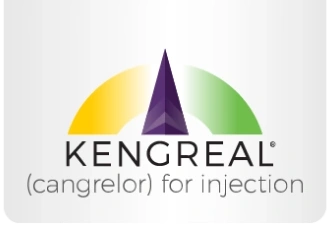Choose KENGREAL® (cangrelor), the Only IV P2Y12 Platelet Inhibitor1
For Confidence During High-Risk or Complex PCI*
Count on KENGREAL for platelet inhibition with a rapid 2-minute onset and 1-hour offset.1
PharmacologyConsider KENGREAL for high-risk PCI cases
Learn about KENGREAL’s benefit in PCI and its potential to reduce thrombotic events.2,3
Clinical DataDosing not impacted by age or renal/hepatic function1
Weight-based dosing for both bolus and infusion administration, can be prepared in the Cath Lab.
Dosing & AdministrationClinical insights into using KENGREAL in PCI
Learn more about KENGREAL’s important role in PCI.

Which cases call for KENGREAL?
Time is of the essence. See patient scenarios that call for KENGREAL, including a STEMI case, an NSTEMI case, and an emergent case in a patient with absorption issues.
See Use Cases
Explore clinical
resources
Learn more about KENGREAL through these go-to resources, including dosing and stocking instructions.
See ResourcesIV=intravenous; NSTEMI=non-ST-elevation myocardial infarction; PCI=percutaneous coronary intervention; STEMI=ST-elevation myocardial infarction.
*In a post hoc analysis of CHAMPION PHOENIX, the absolute benefit of KENGREAL increased progressively with the number of high-risk lesion features treated and was greatest for patients with ≥3.2
Important Safety Information
KENGREAL® (cangrelor) for Injection is contraindicated in patients with significant active bleeding.
KENGREAL® is contraindicated in patients with known hypersensitivity (e.g., anaphylaxis) to cangrelor or any component of the product.
Drugs that inhibit platelet P2Y12 function, including KENGREAL®, increase the risk of bleeding. In CHAMPION PHOENIX, bleeding events of all severities were more common with KENGREAL® than with clopidogrel. Bleeding complications with KENGREAL® were consistent across a variety of clinically important subgroups. Once KENGREAL® is discontinued, there is no antiplatelet effect after an hour.
The most common adverse reaction is bleeding.
Please see Full Prescribing Information.
Indication
KENGREAL® (cangrelor) for Injection is a P2Y12 platelet inhibitor indicated as an adjunct to percutaneous coronary intervention (PCI) to reduce the risk of periprocedural myocardial infarction (MI), repeat coronary revascularization, and stent thrombosis (ST) in patients who have not been treated with a P2Y12 platelet inhibitor and are not being given a glycoprotein IIb/IIIa inhibitor.
References: 1. KENGREAL® (cangrelor) Prescribing Information. 2022. 2. Stone GW, Généreux P, Harrington RA, et al. Impact of lesion complexity on peri-procedural adverse events and the benefit of potent intravenous platelet adenosine diphosphate receptor inhibition after percutaneous coronary intervention: core laboratory analysis from 10,854 patients from the CHAMPION PHOENIX trial. Eur Heart J. 2018;39(46):4112-4121. 3. Bhatt DL, Stone GW, Mahaffey KW, et al; CHAMPION PHOENIX Investigators. Effect of platelet inhibition with cangrelor during PCI on ischemic events. N Engl J Med. 2013;368(14):1303-1313.

